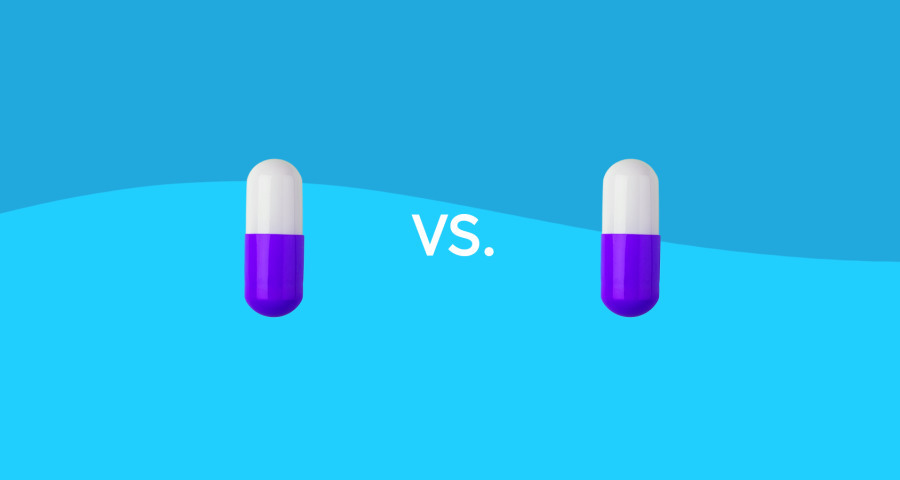
Comparing Dutasteride vs Finasteride for Hair Loss
Hair loss can be a distressing experience, and finding the right treatment is crucial for regaining confidence and self-esteem.
Dutasteride vs. Finasteride are two popular medications used to treat hair loss, but how do they differ, and which one is the best choice for you?
In this comprehensive guide, we will delve into the origins, uses, mechanisms of action, effectiveness, and potential side effects of both drugs.
We will also explore topical alternatives and provide guidance on choosing the right hair loss treatments based on the severity of hair loss and individual needs.
Short Summary
-
Dutasteride and Finasteride are 5-alpha reductase inhibitors used to treat male pattern hair loss, with Dutasteride having greater inhibitory potency.
-
Finasteride is a commonly prescribed first-line treatment for mild to moderate hair loss while Dut

I LOVE MY HAIR NOW
FullyVital hair serum and hair vitamins made tremendous improvements in my hair. I truly love my hair now.
Meg S.,
Understanding Dutasteride and Finasteride
Dutasteride and Finasteride are medications that belong to a class called 5-alpha reductase inhibitors, which work by inhibiting the conversion of testosterone into dihydrotestosterone (DHT).
They are commonly used to treat male pattern hair loss, also known as androgenetic alopecia, which accounts for 95% of hair loss cases in men and a large majority of hair thinning in women.
Although both drugs share some similarities, they also have distinct differences in their origins, uses, and levels of effectiveness.
Dutasteride is a synthetic drug developed by GlaxoSmithKline.
Dutasteride: Origins and Uses
Dutasteride was designed to treat benign prostatic hyperplasia (BPH), a condition also known as enlarged prostate.
This is a medical condition that involves enlargement of the prostate. However, due to its stronger DHT-blocking effects compared to Finasteride, Dutasteride has also been studied as a potential treatment for male pattern baldness.
While it is not yet approved by the FDA for hair loss treatment, it has been used off-label to treat BPH with promising results.
Dutasteride is typically administered once daily and works by inhibiting both types of the enzyme responsible for converting testosterone to DHT.
Finasteride: Origins and Uses
Finasteride, on the other hand, has been approved by the FDA for treating male pattern hair loss since 1997.
It works by inhibiting the conversion of testosterone to DHT, thus preserving hair follicles.
Finasteride is available in 1mg tablets and is typically administered once daily.
The FDA approval went a long way towards increasing individuals using finasteride.
It is important to note that continuous use of finasteride is required to maintain its effectiveness in treating hair loss.
Mechanism of Action: How They Combat Hair Loss
Both Dutasteride and Finasteride combat hair loss by inhibiting the conversion of testosterone to DHT, a hormone that has been closely correlated with male pattern baldness.
DHT binds to androgen receptors in the scalp, causing hair follicles to miniaturize over time and eventually leading to hair loss.
By blocking the conversion of testosterone to DHT, Dutasteride and Finasteride help reduce scalp DHT levels, preserve the hair follicle and promote hair growth.
DHT's Role in Hair Loss
DHT, or dihydrotestosterone, is a hormone derived from testosterone, and it plays a significant role in hair loss.
When DHT binds to androgen receptors in the scalp, hair follicles shrink and lose their ability to produce long, thick, pigmented hairs, a process known as “miniaturization”.
This miniaturization can hinder hair regrowth.
This miniaturization is the primary cause of male and female pattern baldness, which affects a large percentage of men worldwide.
Inhibitory Potency: Dutasteride vs Finasteride
When it comes to inhibiting 5-alpha reductase enzymes, Dutasteride has been shown to be more potent than Finasteride in blocking DHT.
A study found that a 5mg per day dose of dutasteride reduced DHT levels by approximately 98.4%, while finasteride lowered DHT by 70.8% at the same dosage.
When dutasteride compared to finasteride, it seems to be more effective in suppressing DHT levels.
Also, its DHT-blocking effects appear to be more consistent.
Effectiveness: Comparing Results
While the long-term effectiveness of both drugs is still under investigation, studies have shown that Dutasteride is more effective than Finasteride in both the short-term and long-term for treating hair loss.
In the following sections, we will compare the short-term and long-term effectiveness of Dutasteride and Finasteride in treating hair loss and maintaining healthy hair.
Short-term Effectiveness
In terms of short-term effectiveness, Dutasteride has shown greater results than Finasteride.
After 24 weeks of treatment, men taking Dutasteride experienced a 25% increase in hair count, whereas those taking Finasteride reported a 17% increase.
This higher average hair count after 24 weeks indicates that Dutasteride may be a more effective option for individuals looking for faster results in hair growth.
Long-term Effectiveness
Although long-term studies on the effectiveness of Dutasteride and Finasteride are still limited, head-to-head studies have shown promising results for Dutasteride in terms of hair growth and maintenance.
For instance, a study comparing the long-term effectiveness of Dutasteride and Finasteride found that Dutasteride had a higher efficacy in terms of hair count and patient satisfaction.
However, it is crucial to consider the potential risks and benefits of each drug before deciding on a treatment plan.
Side Effects: Weighing the Risks
As with any medication, it is crucial to understand the potential side effects of Dutasteride and Finasteride before starting treatment.
Both drugs have similar side effects, including sexual dysfunction and an increased risk of depression, but some rare but serious side effects may also occur.
In the following sections, we will explore the common and rare but serious side effects of Dutasteride and Finasteride.
Common Side Effects
The most common side effects of both Dutasteride and Finasteride are sexual dysfunction, including decreased libido, and an increased risk of depression.
Sexual dysfunction may manifest as erectile dysfunction or decreased ejaculate volume, while depression may present as persistent feelings of sadness, hopelessness, or a loss of interest in activities once enjoyed.
It is important to discuss these potential side effects with a healthcare provider before starting treatment, and to monitor any changes in physical or mental health while taking the medication.
Rare but Serious Side Effects
In addition to the common side effects, there are also some rare but serious side effects associated with Dutasteride and Finasteride.
These include birth defects in pregnant women and a potential increased risk of prostate cancer.
Pregnant women or those who may become pregnant should avoid handling these medications, as they can be absorbed through the skin and may cause harm to the developing fetus.
It is essential to discuss these risks with a healthcare provider before starting hair loss treatments, and to carefully weigh the potential benefits and risks of each drug.
Topical Alternatives: Exploring Other Options
For individuals who prefer a topical treatment or wish to avoid the systemic side effects of oral Dutasteride and Finasteride, there are topical hair loss treatments available to treat male pattern baldness.
These alternatives have been found to be effective treatments for hair loss and androgenic alopecia, with fewer systemic side effects compared to their oral counterparts.
In the following sections, we will discuss topical Finasteride and topical Dutasteride, including their effectiveness and potential side effects.
Topical Finasteride
Topical Finasteride is a form of the medication that is applied directly to the scalp, and clinical studies have indicated that it is an effective treatment option for hair loss and androgenetic alopecia.
The topical form of Finasteride has similar effects to the oral form, but with fewer systemic side effects, as the medication is localized to the application site.
However, systemic absorption may still occur, so it is important to discuss the potential risks and benefits with a healthcare provider before starting treatment.
Topical Dutasteride
Topical Dutasteride is another option for individuals seeking a topical treatment for hair loss.
It is applied directly to the scalp and has been found to be an effective treatment option for fighting hair loss and male pattern baldness.
Topical dutasteride has similar effects to oral dutasteride but with lower systemic side effects, with the side effects being localized to the application site.
However, studies on the effectiveness and side effects of topical Dutasteride are limited, so it is essential to discuss this treatment option with a healthcare provider before starting therapy.
Choosing the Right Treatment: Dutasteride vs Finasteride
Ultimately, the choice between Dutasteride and Finasteride for treating hair loss depends on individual needs and the severity of hair loss.
In the following sections, we will provide guidance on choosing the right treatment for mild to moderate hair loss and advanced hair loss, considering the potential risks and benefits of each drug.
For mild to moderate hair loss, finasteride is generally the preferred option. It is.
Mild to Moderate Hair Loss
For individuals experiencing mild to moderate hair loss, Finasteride is generally recommended as the first-line treatment due to its FDA approval and lower potency compared to Dutasteride.
Finasteride is effective in treating mild to moderate hair loss and is available in a convenient once-daily tablet.
However, it is important to remember that continuous use of finasteride is required to maintain its effectiveness in treating hair loss.
Advanced Hair Loss
In cases of advanced hair loss, Dutasteride may be a better option due to its increased potency in inhibiting DHT production.
However, individuals should carefully weigh the potential risks and benefits of Dutasteride before choosing this treatment, as it is not yet FDA-approved for hair loss treatments and may have more potent side effects compared to Finasteride.
It is essential to discuss treatment options with a healthcare provider who can provide personalized recommendations based on individual needs and medical history.
Summary
In conclusion, both Dutasteride and Finasteride are effective treatments for hair loss, with Dutasteride showing greater effectiveness in both short-term and long-term studies.
However, it is crucial to understand the potential side effects and risks associated with each drug, as well as to consider alternative treatments such as topical Finasteride and Dutasteride.
By understanding the differences between these medications and discussing treatment options with a healthcare provider, individuals can make an informed decision on the best course of action for androgenetic alopecia.
Frequently Asked Questions
Which is better dutasteride or finasteride?
Studies have concluded that dutasteride is more effective at treating androgenic alopecia, with a broadly similar rate of potential side effects as finasteride.
Therefore, dutasteride appears to be the better option.
What are the downsides of dutasteride?
Dutasteride can cause decreased libido, erectile dysfunction, ejaculation disorders, and gynecomastia.
Additionally, it may increase the risk of high-grade prostate cancer and affect results of the PSA test.
Women who are or may be pregnant should avoid handling dutasteride capsules due to potential birth defects from skin absorption.
Can you still go bald on dutasteride?
Dutasteride may cause some thinning of existing hair in the initial months, however this is usually only temporary due to shedding of miniaturised hairs.
Therefore, baldness should not be an effect of dutasteride treatment.
How long does it take to see results with Dutasteride and Finasteride?
Results of Dutasteride and Finasteride typically start to show after around six months.
Are there topical alternatives to oral Dutasteride and Finasteride?
Yes, topical alternatives to oral Dutasteride and Finasteride are available and have been found to be effective treatments for androgenic alopecia with fewer systemic side effects.
These alternatives include topical minoxidil, which is available over the counter, and topical spironolactone, which is available by prescription.
Both of these medications have been found to be effective in treating hair loss, and they have fewer systemic side effects.







